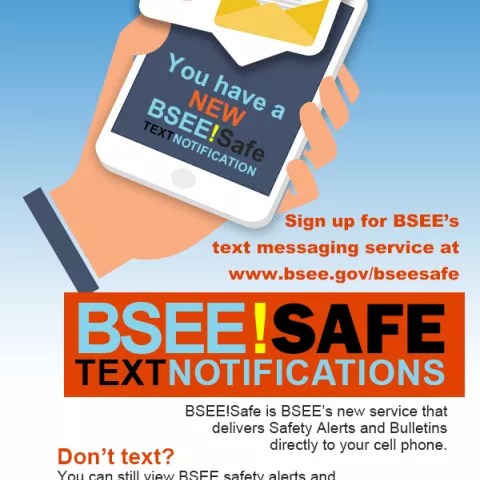
You are viewing ARCHIVED content published online before Jan. 20, 2025. Please note that this content is NOT UPDATED,
and links may not work. Additionally, any previously issued diversity, equity, inclusion or gender-related guidance on
this webpage should be considered rescinded. For current information, visit
News Items | Bureau of Safety and Environmental Enforcement.
NEW ORLEANS -- The Bureau of Safety and Environmental Enforcement (BSEE) is launching a safety initiative to bring critical safety information directly to offshore workers on the Outer Continental Shelf. The BSEE!Safe program uses text messaging notification technology to send links for its published Safety Alerts and Bulletins, tools used to inform the offshore oil and gas industry of the circumstances surrounding an incident or near miss. The alerts and bulletins also contain recommendations to help prevent the recurrence of such an incident on the Outer Continental Shelf.
“Having engaged and informed offshore workers on the front line is the best method to drive safety performance and environmental stewardship improvements,” explained BSEE Director Scott Angelle. “Empowering the more than 36,000 workers on the offshore rigs and platforms with critical safety information is an important step in ensuring safe and environmentally sustainable operations.”
Offshore workers can sign up for the free text notification service at https://bsee.sendwordnow.com/HomePage.aspx. Notices of Safety Alerts, Bulletins, and other safety announcements will be sent via text message with links to the information. BSEE!Safe notifications supplement the long-standing practice of issuing Safety Alerts and Bulletins sharing lessons learned and recommendations from incidents and near misses with industry representatives. In 2018, BSEE issued 22 Safety Alerts and Bulletins.
BSEE!Safe is part of the Bureau’s New Era of Management strategy to supplement regulation with innovative and collaborative programs, expanding the available toolbox of methods for driving safety performance and environmental stewardship improvements.
“This is so smart and will be so effective. We commend the BSEE leadership for using innovation and collaboration to drive safety performance for the men and women wearing hard hats and steel toe boots while working on the Outer Continental Shelf,” said Gregg Falgout, President and CEO of Island Operating Company, the largest privately owned oil and gas lease management company operating in the Gulf of Mexico and in the major shale basins of the United States.
Another key component of the New Era of Management strategy is a Risk Based Inspection program, implemented in March 2018.The Risk Based Inspection program employs a protocol of targeted, risk-focused inspections to supplement BSEE’s existing schedule of inspections on production facilities and active drilling operations. Using data analysis to identify higher-risk operations, BSEE is able to effectively direct additional inspections and resources where needed. These focused field inspections also allow BSEE to verify that operators are properly identifying, managing and mitigating risks.
An existing program that Director Angelle renewed focus on as part of BSEE’s strategy to drive safety performance is a near miss and equipment failure-reporting program, known as SafeOCS. That program allows BSEE to review aggregated incident data to identify trends and emerging issues, potentially reducing risk across the entire Outer Continental Shelf.
“The Trump Administration inherited a four percent participation rate in the voluntary SafeOCS program, said Angelle. “Through a focused outreach effort BSEE has increased participation by operators; the participants now account for 85 percent of all oil production on the U.S. Outer Continental Shelf.”
The Bureau of Safety and Environmental Enforcement (BSEE) is the lead federal agency charged with improving safety and ensuring environmental protection related to the offshore energy industry, primarily oil and natural gas, on the U.S. Outer Continental Shelf (OCS). The number of offshore inspections conducted annually has consistently increased under President Trump. In calendar year 2016, BSEE conducted 8,508 inspections. That number jumped to 9,275 and 10,341 in 2017 and 2018 respectively.
--BSEE--
